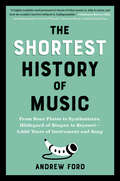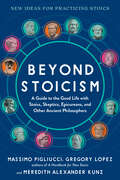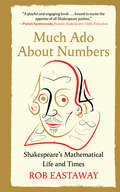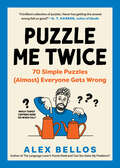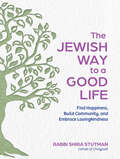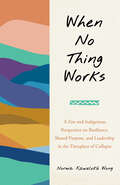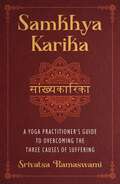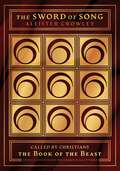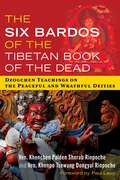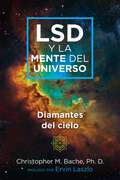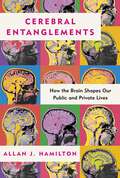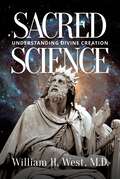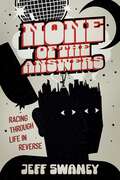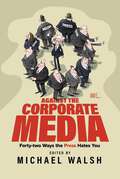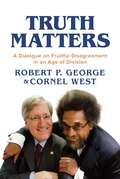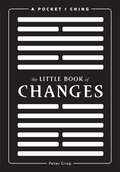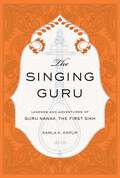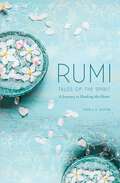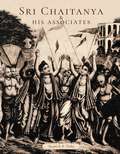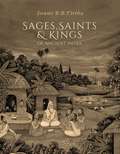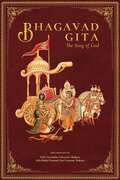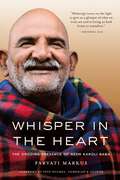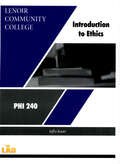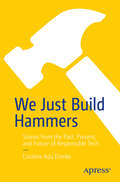- Table View
- List View
The Shortest History of Music: From Bone Flutes to Synthesizers, Hildegard of Bingen to Beyoncé - 5,000 Years of Instrument and Song (The Shortest History Series)
by Andrew FordFrom prehistoric songwriting to digital recording, discover the history of the world’s favorite art form No other art is as popular—or pervasive—as music. With just a few clicks, anyone can cue up (and critique) Chopin or Cher, The Bangles or The Beatles—even the brand-new Beyoncé. But things weren’t always this way. In this brisk, breakneck history under 300 pages, award-winning composer, author, and broadcaster Andrew Ford replays the dramatic evolution of music, from early oral songs to the first orchestras (and their wealthy patrons) and from the emergence of recording technology to the multibillion-dollar industry we know today. The Shortest History of Music explores the immense influence of religion, politics, and the economy on world music, what led humans to make music in the first place, and why—in every era—we are irresistibly drawn to listen to it. The Shortest History books deliver thousands of years of history in one riveting, fast-paced read.
Beyond Stoicism: A Guide to the Good Life with Stoics, Skeptics, Epicureans, and Other Ancient Philosophers
by Massimo Pigliucci Gregory Lopez Meredith Alexander KunzNavigate the challenges of modern life, with ancient and time-tested Greek and Roman thinkers at your side. What is a good life? And how can we create that life in a world filled with uncertainty? Beyond Stoicism invites you to find your own answers to these big questions with help from thirteen of the most prominent Greco-Roman philosophers—many of whom inspired, or were inspired by, the Stoics. By taking cues from the lives and ideas of the Cynics, Epicureans, and others, you’ll learn to: Seek pleasure with Aristippus Strike the right balance with Aristotle Focus on what’s up to you with Epictetus Be a rebel like Hipparchia Embrace uncertainty with Carneades Question everything with Socrates Work toward a just society with Plato And much more Times have changed, but the quest for eudaimonia—a life worth living—stays the same: We still seek pleasure and crave love, avoid pain and fear death. That’s why all these ancient sages can continue to guide us, practicing Stoics and new seekers alike. With exercises to help you test-drive each philosophy today
Much Ado About Numbers: Shakespeare's Mathematical Life and Times
by Rob EastawayOpen a new portal into Shakespeare’s words—and his Renaissance life—with math and numbers as your key. Shakespeare’s era was abuzz with mathematical progress, from the new concept of “zero” to Galileo’s redraft of the heavens. Now, Rob Eastaway uncovers the many surprising ways math shaped Shakespeare’s plays—and his world—touring astronomy, code-breaking, color theory, navigation, music, sports, and more. How reliable was a pocket sundial? Was math illusionist John Dee the real-life Prospero? How long was a Scottish mile, and what could you buy for a groat? Do Jupiter’s moons have a cameo in Cymbeline? How did ordinary people use numbers day to day? And might Shakespeare have tried that game-changing invention—the pencil? Full of delights for devotees of both Tudor history and the Bard, Much Ado About Numbers is proof that the arts and sciences have always danced together.
Puzzle Me Twice: 70 Simple Puzzles (Alex Bellos Puzzle Books #0)
by Alex Bellos“A brilliant collection of puzzles. Never has getting the answer wrong felt so good!”—G. T. Karber, author of Murdle Most people get these puzzles wrong. Will you beat the odds? From mathy mind-benders to eye-fooling illusions, here are 70 perplexing puzzles of every kind. But they all have one key thing in common—a wrong answer that seems so right! In Puzzle Me Twice, you’ll have to think—and think again—to overrule your first instinct and uncover the truth. For example: If a hen and a half lays an egg and a half in a day and a half, how many eggs do half a dozen hens lay in half a dozen days?* Bestselling author Alex Bellos wrangles math and physics, logic and wordplay, optical illusions, card games, and more to tie readers’ brains in pleasurable knots. It’s a merry tour of the many ways our reasoning can go wrong—and how we can be more fool-proof in the future. Puzzle on! *Four times as many hens, over four times as many days, lay 16 times as many eggs: 1.5 × 16 = 24 eggs.
The Jewish Way to a Good Life: Find Happiness, Build Community, and Embrace Lovingkindness
by Rabbi Shira StutmanRest, community, and celebration are for everyone in this radical, refreshing book—where traditional Jewish wisdom becomes essential advice for today “One of the blessings of twenty-first-century globalization is that it allows us entrée into other cultures and traditions. You no longer have to be Jewish to do Jewish.”—from the introduction For as long as Judaism been a religion, “Jewish” has been a culture—one whose unique blend of ritual and realism has kept its people going for some 3,000 years. In The Jewish Way to a Good Life, Rabbi Shira Stutman invites readers of every faith—and none—to do chesed (good work), foster tzedek (justice), practice shabbat (rest), and ultimately find happiness. From Love and Sex to Mourning and Money, Rabbi Shira visits ten realms where we all get lost on occasion, to deliver spirited, sometimes surprising wisdom. On love: Sex is meant to be fun and liberating. On rest: Time is even more sacred than things. Again and again, she reveals how customs have survived not out of obligation, but because they meet our deepest needs—from shiva, which allows mourning families not to be OK, to the unbridled joy of dancing the hora at weddings. For anyone seeking community, meaning, or simply “something more,” The Jewish Way to a Good Life offers practical, time-tested ways to enrich our daily routines and engage those around us. By looking in and reaching out, we can all help tikkun olam—heal the world. #1 Bestseller in Women & Judaism
When No Thing Works: A Zen and Indigenous Perspective on Resilience, Shared Purpose, and Leadership in the Timeplace of Collapse
by Norma WongSpiritual and community lessons for embracing collective care, co-creating sustainable worlds, and responsibly meeting uncertain futures—a Zen and Indigenous take on building better, more balanced ways of being For readers of Hospicing Modernity, When Things Fall Apart, and Zen and the Art of Saving the PlanetTalking story, weaving poetry, and offering wisdom at the intersections of strategy, politics, and spiritual activism, When No Thing Works is a visionary guide to co-creating new worlds from one in crisis. It asks into the ways we can live well and maintain our wholeness in an era of collective acceleration: the swiftly moving current, fed and shaped by human actions, that sweeps us toward ever uncertain futures. Grounded in Zen Buddhism, interconnection, and decades of community activism, When No Thing Works explores questions like:As we stand at a threshold of collective change, what leaps must we make?How can we push through discord and polarization and meet these critical changepoints collectively?What practices, strategies, and spiritualities can align to vision a sustainable future for our communities and descendents?How can we step out of urgency to tend to our crises with wisdom, intention, and care? With wise and witty prose that wanders and turns, guides and reveals, Zen master and Indigenous Hawaiian leader Rōshi Norma Wong&’s meditation holds our collective moment with gravity and tender care. She asks us to not only imagine but to live into a story beyond crisis and collapse—one that expands to meet our dreams of what (we hope) comes next, while facing with clarity and grace our here and now in the world we share today.
Samkhya Karika: A Yoga Practitioner's Guide to Overcoming the Three Causes of Suffering
by Srivatsa Ramaswami• Explores the meaning of all 72 verses of the 4th-century Sanskrit text Samkhya Karika word by word, providing helpful explanations and annotations to aid your understanding• Reveals how Samkhya Karika explains the three duhkhas, or causes of suffering, and how to deal with them to reach a state of freedom from pain and suffering• Shows how Samkhya Karika explains the origin and evolution of the universe and how it identifies the true nature of the Self, the Atman, as unvarying consciousness distinct from the body-mind complexAlong with Yoga and Vedanta, Samkhya is one of the three schools of Vedic philosophy that teach the individual how to break free from the cycles of death and rebirth. Samkhya Karika is the earliest surviving text on Samkhya, a brilliant masterpiece written by fourth-century Indian poet and philosopher Ishvarakrishna, who was considered to be an avatar of the Classical Sanskrit poet Kalidasa.Presenting a translation of Samkhya Karika from the original Sanskrit along with detailed commentary, Srivatsa Ramaswami explores the meaning of all 72 slokas (verses) word by word, providing helpful explanations and annotations to aid in your understanding. He shows how Samkhya philosophy explains the origin and evolution of the universe and how it identifies the true nature of the Self as unvarying consciousness, distinct from the empirical body-mind complex. He reveals how Samkhya Karika explains the three duhkhas, or causes of suffering, and how to deal with them to reach the goal of Samkhya: kaivalya, a state of deep contemplation where one is unafflicted by pain and eternally free from the cycle of samsara.Providing a user-friendly guide to Samkhya for yoga practitioners and students of yoga philosophy, this book also shares insightful teachings from the author&’s teacher, the legendary Sri Krishnamacharya, hailed as "the father of modern yoga."
The Sword of Song: Called by Christians The Book of the Beast
by Aleister Crowley• Presents Crowley&’s preferred text, drawing on all existing draft manuscripts and margin notes from Crowley&’s personal copies• Contains an introduction and explanatory notes by Crowley biographer Richard Kaczynski, helping to illuminate obscure passages and references• Includes Crowley&’s mystical essays on his first forays into sex magic, his initial embrace of the legendary title of &“the Beast,&” and his encounters with the Golden Dawn, Buddhism, Agnosticism, and ChristianityToo inflammatory for English publishers, Aleister Crowley printed The Sword of Song, his first talismanic work, in Paris in 1904, releasing a mere one hundred copies. Deconstructing his encounters with the Golden Dawn, Buddhism, Agnosticism, and Christianity, the book explored Crowley&’s magic and spiritual philosophy before he experienced the revelation that led to The Book of the Law. The Sword of Song also contained Crowley&’s first manifesto, his first forays into sex magic, his initial embrace of the legendary title of "the Beast," the occult poem "Ascension Day," and mystical essays.Now in this fully annotated deluxe hardcover edition, renowned Crowley biographer Richard Kaczynski presents Crowley&’s preferred text for The Sword of Song, drawing on all existing draft manuscripts as well as unpublished margin notes from Crowley&’s personal copies of the book. Kaczynski clarifies all the significant changes and additions throughout the book&’s various iterations and provides explanations for the many occult and popular culture references. He also includes a substantial scholarly introduction, reflecting an intimate knowledge of Crowley and the development of his magical practice.Kaczynski demonstrates how The Sword of Song was not only a prototype for Crowley&’s later works such as Konx Om Pax and The Book of Lies, but that The Sword of Song's blend of poetry, allegory, fiction, and essay reveals the formative inner workings of one of the twentieth century&’s most provocative thinkers just before he received the life-changing Book of the Law from the discarnate entity Aiwass.
The Six Bardos of the Tibetan Book of the Dead: Dzogchen Teachings on the Peaceful and Wrathful Deities
by Ven. Khenchen Palden Sherab Rinpoche Ven. Khenpo Tsewang Dongyal Rinpoche• Shares ancient Tibetan wisdom to help readers break through the process of &“ego-clinging&” to find deeper freedom and escape from feelings of lack and scarcity• Offers authentic guidance and support for confidence in overcoming challenges, bravery in caring for the self and others, as well as fearlessness in the face of dying• Examines key concepts and history in Dzogchen Buddhism, including a guide to the Vajrayana teachings, the Bardo teachings, and the role of the five elementsAccording to the Buddha, all sentient beings are naturally enlightened and have been pure since the beginning. However, in waking life, grasping and fear develop into ego-clinging and a cyclic state of delusion. This interval from the beginning of delusion until we return to our primordial nature is known as the bardo. Until we rediscover enlightenment, everything we feel, know, and experience is bardo phenomena.Exploring this understanding, so essential to the myriad schools of Buddhism, in rich and practical detail, renowned Dzogchen masters Ven. Khenchen Palden Sherab Rinpoche and Ven. Khenpo Tsewang Dongyal Rinpoche offer a guide to implementing the teachings of the bardos of life and death from the Bardo Thodrol, commonly known as The Tibetan Book of the Dead. Drawing on their Dzogchen background—a Buddhist lineage focused on resting and abiding in our true nature—the authors explore key ideas from the famous Tibetan text, including the Vajrayana teachings, the five elements, peaceful and wrathful deities, and the nature of the six bardos (with particular emphasis on the bardo of dying). The authors provide practical advice for deeper self-awareness, improved care of the self and others, and confronting challenges fearlessly, especially the process of dying.The teachings offered by the authors in this guide are truly universal, offering a path out of delusion and allowing us all to &“ignite our inner light&” and rediscover our inner buddha nature as we move forward on the path to enlightenment.
LSD y la mente del universo: Diamantes del cielo
by Christopher M. Bache• Crónicas, con un rigor sin precedentes, del viaje sistemático del autor hacia un campo unificado de consciencia que subyace en toda existencia física• Presenta argumentos poderosos a favor del valor de la experiencia espiritual inducida psicodélicamente y analiza el desafío de integrar estas experiencias en la vida cotidiana• Muestra cómo la experiencia psicodélica puede llevarte más allá de la autotransformación hacia una transformación colectiva y ayudar a que nazca el futuro de la humanidadEl 24 de noviembre de 1979, Christopher M. Bache dio el primer paso en lo que se convertiría en un viaje que cambiaría su vida. A partir de su formación como filósofo de la religión, Bache se propuso explorar su mente y la mente del universo de la manera más profunda y sistemática posible, con la ayuda de la droga psicodélica LSD. Siguiendo los protocolos establecidos por Stanislav Grof, las 73 sesiones de altas dosis de LSD de Bache a lo largo de 20 años lo llevaron a una comunión cada vez más profunda con la consciencia cósmica.Viaje junto al profesor Bache mientras toca la inteligencia viva de nuestro universo, una inteligencia que lo abrazó y lo aplastó, y demuestra cómo la experiencia directa de lo divino puede cambiar su perspectiva sobre temas centrales en filosofía y religión. Al narrar sus 73 sesiones, el autor revela la espiral de muerte y renacimiento que lo llevó a través del inconsciente colectivo hasta la inteligencia creativa del universo. Al defender poderosamente el valor de la experiencia espiritual inducida psicodélicamente, Bache comparte su inmersión en el amor feroz y la intención creativa del campo unificado de consciencia que subyace en toda existencia física. Describe el valor incalculable de aceptar el dolor y el sufrimiento que encontró en sus sesiones y los desafíos que enfrentó al integrar sus experiencias en su vida cotidiana. Su viaje documenta un cambio de la consciencia individual a la consciencia colectiva, de la realidad arquetípica a la unidad divina y la luminosidad diamante que se encuentra fuera de la existencia cíclica.Al ampliar los límites de la teoría y la práctica, el autor muestra cómo la experiencia psicodélica puede llevarte más allá de la autotransformación hacia la transformación colectiva, más allá del presente hacia el futuro, revelando espíritu y materia en perfecto equilibrio.
Cerebral Entanglements: How the Brain Shapes Our Public and Private Lives
by Allan J. HamiltonA profound and profoundly important book that, using the most up-to-date revolutionary discoveries in neuroscience, shows us how to understand the brain; how it allows us to think, feel, experience and perceive, written by an acclaimed Harvard-trained neurosurgeon.It took a brain surgeon who&’s spent a lifetime in the operating room experiencing the brain's union of form and function to write this book. Cerebral Entanglements, unlike most books on the brain, looks at the intimate and vital emotions in our lives, and shows as well, how neuroimaging studies can transform our understanding of crucial emotional or mental health concerns. Why do we love? Why do we hate? Why do we kill? Why do we laugh? Why do we have faith? Why does time stand still or speed up? Focusing on the nature of consciousness, affection, trust, romance, empathy, kindness; prejudice, sadness, happiness, depression, grief, and the nature of laughter, the author shows us how neuroscience has changed our understanding of these emotions as he explores the extraordinary revelations that have emerged from brain imaging and functional studies. We see that we are the first generation to perceive the contours of a human thought, track the course of an emotion, even watch memory come together. Allan Hamilton writes clearly and accessibly, about the complex science driving our emotions and experiences, and shows how our newfound knowledge can impact our well-being, individually and as a society. As the book explores the nature of happiness, laughter, stress, PTSD. Hamilton writes about how the brain perceives and experiences music, memory, and time itself.
Sacred Science: Understanding Divine Creation
by William H. WestIf you review of the impulses that created the universe, directed the unfolding of life, and empowered human consciousness you reach an undeniable conclusion: an omnipotent Creator supervised the unfolding of our universe.From the moment of creation to the emergence of a planet tailor-made for life, from the journey of multi-million species to the development of an upright creature hungry for God, science tells a sacred story: a superintelligent Creator used His mathematical genius to convert lifeless equations into galaxies, planets, and people. His love has been visible throughout the process. Could our journey reflect thousands of random accidents with no divine guidance? Creation delivered impulses that filled the universe with galaxies and stars. Eliminate any one of those blueprints and the universe would have been stillborn. Stars produced a perfect mix of elements to bring the universe to life. Without a robust ensemble of gene and protein sequences, life might still be living at the bottom of the sea. Hundreds of human genes convert the neurons of a human infant into trillions of networks in an adult brain. Without those God-given genes, a dangerous world may have left us trapped in the treetops with no interest in science at all. But God shared His mind and triggered the emergence of human consciousness. Where do we find ourselves after centuries of that scientific searching? We see that science reflets its source. Science is a gift of God&’s creative love, and is nothing less than sacred!
Embracing Infinite Possibilities: Letting Go of Fear to Find Your Highest Potential
by Dr. Bernard A. Harris JrDr. Bernard Harris shares his journey, and an honest discussion of his struggles, ambitions, hopes and dreams, as a testimony to the voyage that we all face with a desire to discover the power from within.All of us have to deal with external challenges at some point in our lives. Liberation comes when you discover just how unimportant these things really are. Then you will no longer see the world around you as hostile and unforgiving. This reality will free you to be who you really are. There is great power with this realization! Self-endowed power that releases you from the burden of self-doubt. There is no greater power in the world, except that of God. This is, in fact, the truth that God wants for each of us. The realization of our own strength, that is, we are an integral part of something greater than ourselves. One of Harris&’s lifelong goals is to instill inspiration as well as aspiration in people. Embracing Infinite Possibilities looks to build on these ideas by serving as a roadmap to discover the power within each of us. If we are students of the universe, it is clear to me that each of us must find this power within to find our own way and in our own time—some through the experiences of life, some by reading, others by observing, being taught or through self-study. Harris encourages the reader to find their own path. As a companion to his first book, Dream Walker, Embracing Infinite Possibilities will open their mind to the infinite possibilities of life, instilling hope in those who have yet to discover their own power.
None of the Answers: Racing Through Life in Reverse
by Jeff SwaneyYou&’re invited to take a wild ride in life with tenacity, risk, danger, and near death—yielding lessons, rewards and mantras—Buckle Up!None of the Answers is a revealing memoir by successful American entrepreneur Jeff Swaney. Written in the lost art of Gonzo journalism, the stories chronicle a life lived outside the box. Follow Swaney from the start of his life, born dirt poor in Detroit, Michigan—facing the challenges of a city collapsed around him to fast forward reflections of a life well lived. Death-defying outdoor stunts, collegiate misadventures, penniless far-flung world travel, and birthing illegal night clubs would eventually lead to Swaney becoming a business leader in the city he loves most—Dallas, Texas. He would go on a life-altering journey, becoming a single father to two young children at age sixty. Moving from rags to riches and financial collapse to astounding recovery, Swaney brings an inspired world view. This rich, textured page-turner launches the reader into memory lane, inspiring a search for our own best selves through reflection and questioning beliefs. It explores how we take the chaos of living full out, thriving with patience, perseverance, and purpose. The search for answers with pants pulled down self-deprecation provides an avenue for the reader&’s innocuous introspection, hair pulling, and deep belly laughs. Highly entertaining, None of the Answers recounts terrifying experiences on mountain summits, illegal all-night parties, and unspeakably difficult family tragedy, validating that we are all a little crazy navigating this world gone mad. It&’s a tell-all. Fasten your seatbelts!
Against the Corporate Media: Forty-two Ways the Press Hates You
by the-Pipeline.orgThe citizens of Western democracies have been relentlessly propagandized, lied to, and fed a steady diet of distortions and untruths by their media for decades. Editor Michael Walsh brings together a stellar collection of critical thinkers and writers to explain how and why this is happening, its negative effects on our democracies, and what we can do to reverse it.An informed electorate is a prerequisite for free and fair elections. But rather than striving for accuracy and objectivity, today&’s journalists openly celebrate the death of objectivity, arguing that they have a &“higher duty&” to reject the conservatism, police speech, and suppress news that contradicts the liberal narrative. Now, on the heels of his magisterial volume Against the Great Reset, editor Michael Walsh presents Against the Corporate Media, a collection of more than forty essays on the decline and fall of the American and international news media. The book&’s list of distinguished contributors includes Lance Morrow, Andrew Klavan, John O&’Sullivan, Elizabeth Nickson, Monica Crowley, Charlie Kirk, Glenn Reynolds, Steven F. Hayward, John Fund, Armond White, Michael Ramirez, Walsh, and others. Readers around the world deserve to know how badly their media has been corrupted, how eagerly they have embraced the role of official propagandists, and what a threat to democracy they have become. This book marks an important strike against the corporate media, and its unholy alliance with the enemies of freedom everywhere.
Truth Matters: A Dialogue on Fruitful Disagreement in an Age of Division
by Cornel West Robert P. GeorgeTwo leading public intellectuals and dear friends—one progressive, one conservative—explore What is Truth? and Why Does Truth Matter?In Truth Matters, Cornel West and Robert P. George address a range of social issues on which Americans today are bitterly divided. Their book models robust intellectual engagement and civil discourse as they explore vital questions surrounding the idea of truth and its foundational role in our lives. Along the way, they reflect on social conditions—such as respect for freedom of speech—that must be established and maintained if truth is to be seriously pursued. They also explore the virtues—such as intellectual humility and courage—that must be acquired and practiced if we frail, fallible, fallen human beings are to be determined truth seekers and bold truth speakers.
The Little Book of Changes: A Pocket I-Ching
by Peter CrispA Simon & Schuster eBook. Simon & Schuster has a great book for every reader.
The Singing Guru: Legends and Adventures of Guru Nanak, the First Sikh
by Kamla K. KapurPart fiction, history, and mythology, this unconventional retelling of the life of divine spiritual master Guru Nanak, founder of the Sikh religion and revered by Muslims and Hindus alike, provides an intimate look at the enlightened Guru while bringing his ancient wisdom to a modern audience.From the best-selling author of Ganesha Goes to Lunch and Rumi&’s Tales from the Silk Road comes an original novel about the life and travels of Guru Nanak, a musician, enlightened thinker, and one of the most beloved figures in Eastern spirituality. In this fascinating book, Kamla K. Kapur weaves together facts, legends, folktales, myths, and over forty of Guru Nanak&’s poems—preserved in the Sikh holy book, the Granth Sahib—to form this captivating depiction of the leader&’s life. From being seduced by deadly women to almost getting eaten by cannibals, the exciting account presented in The Singing Guruincludes moral tales without being proselytizing. Factual details are intermingled with fantasy to produce a symbolic portrait in which humor and imagination combine to convey a profound and entertaining spiritual narrative.
Rumi: A Journey to Healing the Heart
by Kamla K KapurRetold in award-winning writer Kamla K. Kapur&’s elegant, flowing language, Rumi&’s tales of wisdom and humanity are given fresh life in this modern masterpiece.Rumi: Tales of the Spirit is a sweet, comforting, and at times, fiery guide to nourishing the spirit. In a hopeful but pragmatic tone, timeless storyteller Rumi and award-winning author and playwright Kamla Kapur guide us through the trials of life and teach us to embrace suffering, to pray even when it feels hopeless, and ultimately, to surrender to the cosmic will. In twelve fresh and powerful tales of wisdom, we learn to trust in ourselves and in the universe, experience joy in good times and bad, and find the strength to persevere through life&’s struggles. Kapur has been studying Rumi for twenty years. Through her detailed analysis of his life and work and her own understanding of the human condition and the present-day literary scene, Kapur brings new life to these centuries-old stories while staying true to their roots in Rumi&’s time and place. These retellings convey Rumi&’s deep insight on the human condition and bring to light the vast and subtle meanings of his stories that are often lost in translation. Through this work, we see that people around the world and across time have always been connected by the hopes, dreams, and inner struggles that make up the human experience. Personal, poignant, and woven with fierce passion for life and the divine, Rumi: Tales of the Spirit will leave you with heart-wrenching gratitude for life&’s trials and gifts.
Sri Chaitanya & His Associates
by Swami B. B. Tirtha Maharaja"In this jewel-like volume, the venerable Tirtha Maharaja recounts the nectarean activities of the associates of Lord Gauranga and the acharyas of the Gaudiya Vaishnava religion." ––Swami B.P. Puri, Founder Acharya, Gopinath Gaudiya MathSrila Bhakti Ballabha Tirtha Goswami Maharaja has gathered a great deal of information about the lives of the devotees from numerous sources, and has made this information more relishable by virtue of his own insight. These biographies of Mahaprabhu's devotees should be read on their appearance and disappearance days, for this will bring great joy to both those who hear and those who read them. In this English translation, it will be possible for devotees around the world to enjoy them. Herein, the author delights in the life stories of Jagannath Mishra, Madhavendra Puri, Ishvara Puri, Advaita Acharya, Srivas Pandit, Chandrasekhar Acharya, Pundarika Vidyanidhi, Gadadhar Pandit, Vakresvara Pandit, Gadadhar Das, Shivananda Sen, Paramananda Puri, Murari Gupta, and many others. Every letter of these accounts is drenched with the nectar of devotion. The sincere seeker will never be able to enter the transcendental kingdom nor to advance in the devotional life unless they also discover this delight.
Sages, Saints & Kings of Ancient India
by Swami B. B. Tirtha MaharajaThe people of ancient times were inclined to give their attention not only to the external world of inert matter, but also to the world within, the vital world of consciousness. Those sages who understood the importance of such contemplation comprise the prime subject matter of this book. Especially in the troubled world of today, it is by the conscientious study of their activities and teachings that we may come to understand the Absolute Truth, or the Ultimate Reality, and attain lasting peace and joy. The pastimes of such great, sagely personalities have been narrated in detail in an ancient collection of works known as the Puranas, as well as in timeless epics such as the Mahabharata, Ramayana, and other Vedic literatures. In this book, Srila Bhakti Ballabha Tirtha Goswami Maharaja, a bona fide self-realized representative of the bhakti (devotional) lineage, has narrated important episodes and addressed salient points from these literatures. Thus, the avid reader may understand their inner meaning and apply this knowledge to their search for real happiness. Ultimately, such unadulterated, permanent happiness, according to the devotional tradition, is realized as the attainment of pure love of God, Sri Krishna.
Bhagavad Gita: The Song of God
by Swami B. Puri&“One who sings and chants these supremely confidential teachings to My devotees will attain supreme devotion for Me and will attain Me. There is no doubt in this matter.&” —Sri Krishna, Bhagavad-gita 18.68If sharing the confidential meaning of the yoga of devotional love, bhakti-yoga, is the standard for spiritual advancement, then this is the definitive edition of the Bhagavad-gita. It is the first English translation that includes summaries of the commentaries of four of the most prominent expounders of the tradition of bhakti-yoga: Srimad Bhaktivinoda ?hakura, Srimad Visvanatha Cakravarti Thakura, Srila Bhakti Pramode Puri Gosvami, and Sri Kanailal Pancatirtha—alongside the highly acclaimed translation of the text itself by Srila Bhakti Rakshak Sridhar Dev Gosvami. Taken together, no other edition of this sacred text has so comprehensively conveyed the timeless spiritual wisdom of the Bhagavad-gita.
Whisper in the Heart: The Ongoing Presence of Neem Karoli Baba
by Parvati MarkusWhisper in the Heart documents lively accounts from around the world of Neem Karoli Baba, a great Indian saint, appearing in visions and dreams to offer spiritual comfort and guidance. Neem Karoli Baba left his body in 1973, but his presence has continued unabated. He has appeared to thousands of individuals across the globe, in dreams and visions, in meditation, and out of the blue in broad daylight. He comes to open hearts with a blast of unconditional love, to bring comfort and aid in response to calls for help, and as a reminder that we are, indeed, all One. Whisper in the Heart recounts the stories of over 150 people and the ways in which they &“met&” Maharajji, as he is fondly known. It could have been while chanting at a kirtan, while at a spiritual retreat or in a temple, while looking at a photo or reading a book, or as in some of the more extraordinary stories, when he shows up on a desperate woman&’s doorstep in France, brings years of abuse to an end for a nine-year-old child in Australia, dances on a beach in Miami, or appears to a policeman in Taos, New Mexico. Not just for Maharajji devotees, Whisper in the Heart can help those who are having spiritual experiences of connection with enlightened beings who are no longer in the body to accept their reality and to know that they are not, in fact, &“going crazy.&” Maharajji himself used to say: When you think of me, I&’ll be there. In this book, you will get a glimpse of how he is fulfilling that promise. A LEGACY OF LOVE: Whisper in the Heart continues Neem Karoli Baba's mission of universal love, kindness, and connection PERSONAL STORIES: Includes more than 150 accounts of Maharajji appearing in visions, dreams and even in broad daylight HELPING AND HEALING: Visions of Neem Karoli Baba have helped diverse people from around the world heal spiritually and physically MOTIVATING MESSAGE: The moving stories of Maharajji&’s love can inspire a deeper spiritual practice and connection to humanity RAM DASS COLLABORATION: Neem Karoli Baba&’s teachings were brought to the west by Ram Dass, whose Love Serve Remember Foundation continues to preserve his legacy and spread his message
Introduction to Ethics: PHI-240
by Jeff KautzPHI 240 - Introduction to Ethics(Coll/Tran)Class Hours: 3Lab Hours: 0Clinical/Work Exp. Hours: 0Credit Hours: 3This course introduces theories about the nature and foundations of moral judgments and applications to contemporary moral issues. Emphasis is placed on moral theories such as consequentialism, deontology, and virtue ethics. Upon completion, students should be able to apply various ethical theories to moral issues such as abortion, capital punishment, poverty, war, terrorism, the treatment of animals, and issues arising from new technologies.
We Just Build Hammers: Stories from the Past, Present, and Future of Responsible Tech
by Coraline Ada EhmkePhilosopher Noam Chomsky is famously quoted as saying that technology is neither good nor bad, but simply a neutral tool. He likens it to a hammer, which can be used by carpenters and torturers alike. While the neutrality of tech is an idea that appeals to many technologists, this perspective is out of alignment with today's realities of pervasive ad-tech, surveillance capitalism, algorithmic manipulation, and rising techno-fascism. We Just Build Hammers applies a lens of speculative and science fiction to connect you with a historical lineage of thinkers and activists in the responsible tech movement. Its narrative spans a century of major technological upheavals: from the advent of the atomic age to the formative years of computing; from the hacker visionaries of the turn of the century to the tech justice revolutionaries of today. This book challenges technologists to consider for themselves whether they're really just "building hammers"– technologies whose potential for good balances their potential for harm– or if they are unwittingly contributing to systems that exacerbate inequality, inequity, and injustice. What You Will Learn A historic grounding and a science fiction perspective to help untangle the difficult and fraught topic of tech ethics Ways to bring ethical considerations into the development of new technologies How to navigate the increasing complexity of the techno-social world we live and work in Who This Book is For Designed to appeal broadly, not just to engineers and technologists, but to anyone interested in the history and future of ethics and technology.
